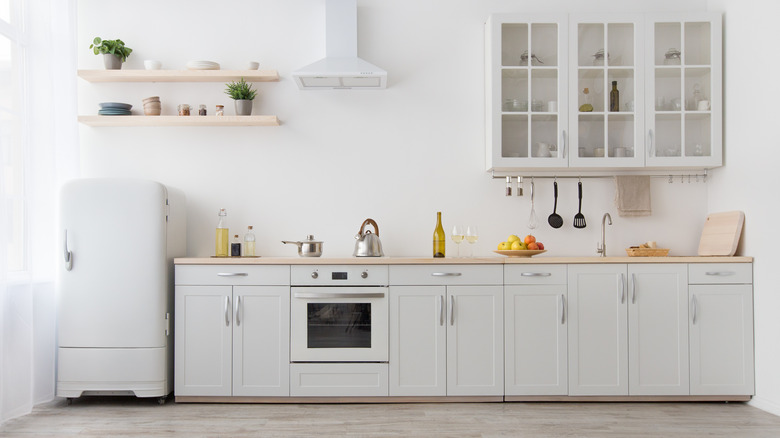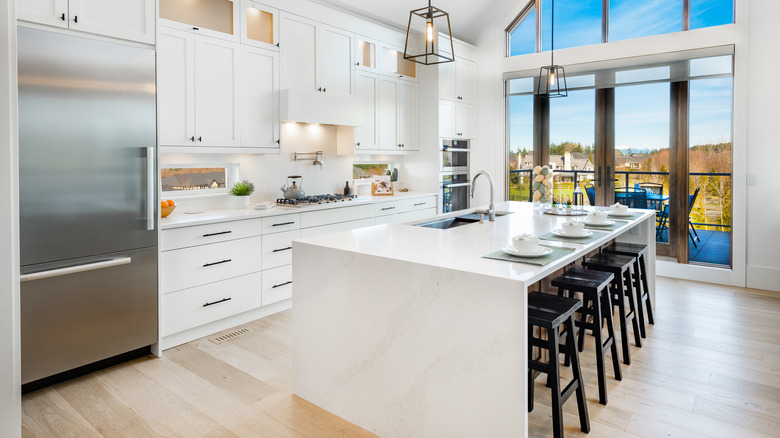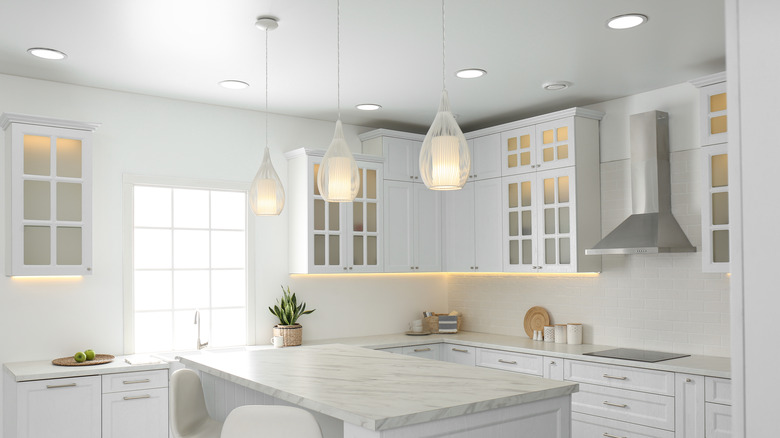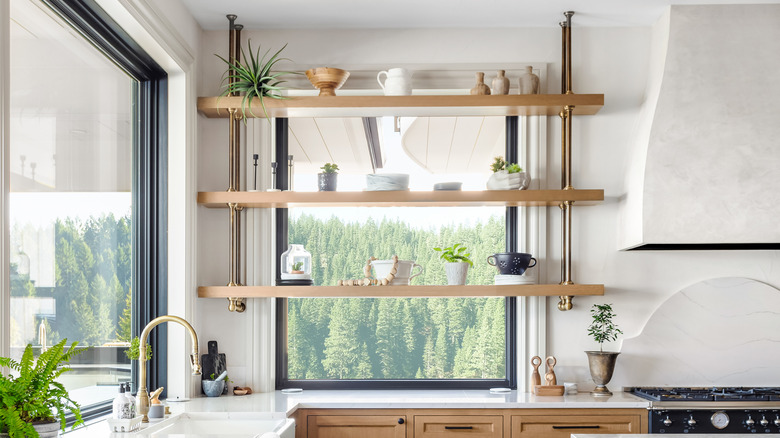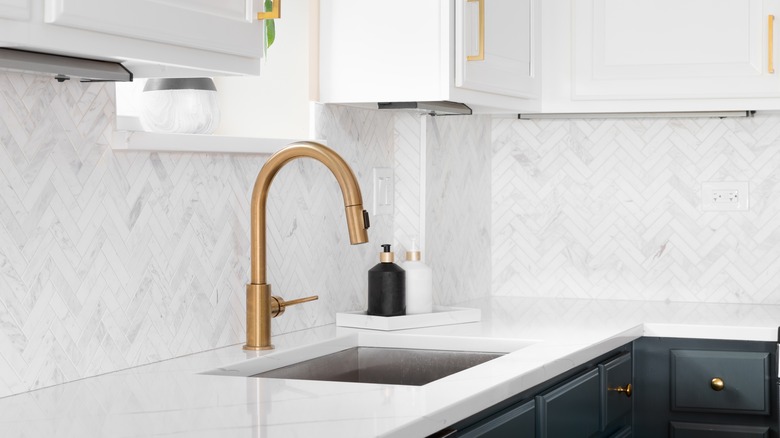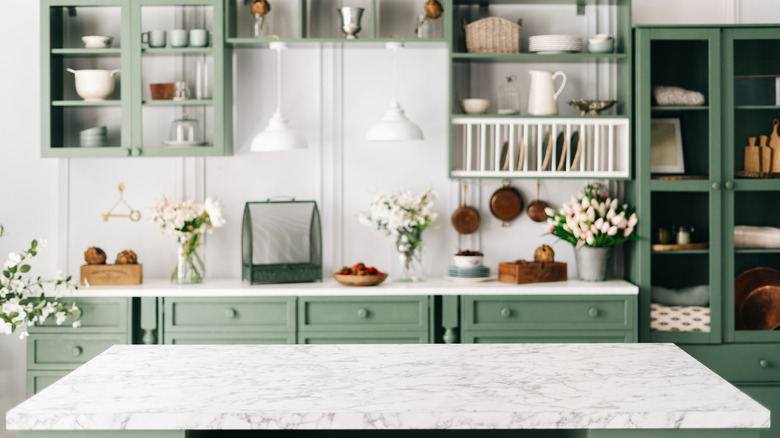5 Savvy Tips For Brightening Up Your Kitchen
Design trends may come and go, but one aesthetic that seems like it's here to stay is a light and bright room. That's because this broad category is similar to a design philosophy or mood rather than a design in itself. You can have a light and bright room with virtually any interior style. This aesthetic is so pleasing because it creates a feeling of openness indoors, according to Brana Designs. Rooms appear larger, and there is a connection with the outdoors.
Many people focus on this style in their living room where they want a wide open space in order to entertain. But it doesn't have to stop there. You can allow the openness to flow right into the kitchen. And one of the best things about this style is that major renovations aren't necessary. Knocking down a wall isn't the first option to make the space appear larger. By using some savvy design tricks, you can give the appearance of a large, airy, and open space.
Light colored countertops
Choosing light colors is the easiest way to bring an airy aesthetic into your home. One of the biggest surfaces in your kitchen is the countertops, so choosing one that's a light color will go far in making the room brighter. All-white kitchens are a very popular design, but if a monochrome look isn't your style, opt for white counters over anything else. The stone can still have some variation to add some depth to the surface.
When it comes to choosing the exact color or material, keep the other colors in the room in mind, says Plank and Pillow. Even if you choose a simple white countertop, this detail should complement other design elements in the kitchen. Gray veining on a white countertop, for example, can pair well with cooler tones throughout the room. However, if the veining is brown or tan, warmer tones in the kitchen may pair better.
Layer your lighting
Interior designers will stress how important lighting is for a design. It's often overlooked as a functional element rather than an aesthetic one. Lighting is both and should be considered as such when designing the space. But it's not as simple as placing a fixture and calling it a day. In order to get the most out of your lighting, you have to know how to layer it. There are three kinds of lighting every room should have: ambient, task, and accent, says Degnan Design Build Remodel. Using a combination of the three ensures you have a balanced lighting design.
Ambient lighting illuminates the whole kitchen and can come from natural light or overhead lighting like chandeliers or flush mount fixtures. Task lighting provides illumination in specific areas where you may need more light to focus on an action. In the kitchen, this could be lighting under the cabinets or pendants over an island. Accent lighting highlights aesthetic or architectural details by using wall sconces or picture lights. Using a combination of these three lighting techniques won't only make your kitchen look professionally designed but will also help brighten it up.
Bring in natural light
Similar to artificial light, your kitchen should be bathed in natural light if you want a light and bright aesthetic. One of the easiest ways to do this is by adding more or larger windows, says Eco Line Windows. Choose windows with minimal framework to allow the most light to come through. Floor-to-ceiling windows or picture windows will make your space appear larger. Bow and bay windows can bring in more light because they protrude from the side of the house. If possible, you can also add skylights for the sun to shine in.
It's also essential not to block any of the natural light coming through, no matter how large your windows are. Consider sheer curtains for window treatments so light filters through, but you still have some privacy. Also, be thoughtful of items you place in front of or near windows. Large furniture can block the light from filling the space.
Reflective surfaces
Double the amount of natural light you have without adding more windows by incorporating reflective surfaces into the kitchen. These surfaces help bounce light around the room and can make it appear brighter. Glossy tiles are a great way to accomplish this as they can make darker rooms appear lighter and smaller rooms appear larger by reflecting light, says Euro Tiles and Bathrooms. Choosing a lighter color can increase the reflective qualities.
Glossy cabinet fronts, counters, and floors can all help light bounce around the room. Mirrored surfaces for backsplash tiles or large mirrors as decor are another way to add reflective surfaces to the kitchen. Keep in mind, though, that you don't want to add too many reflective details, or else the design might look a bit monotonous and unbalanced. So if you opt for a glossy backsplash, you may want to skip cabinets or counters with glossy finishes.
Painted cabinets
One of the largest elements of the kitchen is the cabinets. And if you're going for a light and bright aesthetic, then the color you choose matters. For a brighter kitchen, choose lighter colors. White is one of the most popular cabinet colors, says West Magnolia Charm. It's timeless and flexible for a design while also being a bright surface that light can bounce off of. If a bright, crisp white is too stark for you, then you can opt for an off-white or cream, which can still be a bright, reflective surface. Light grays are also a great option.
Of course, white isn't the only option for a bright kitchen. You can use lighter shades like yellow or orange that imitate natural light. Shades like sage and sky blue add some color while also keeping the light and bright aesthetic. You can also combine colored cabinets like white uppers and blue lowers or all-white cabinets with a green island. This brings in a pop of color for an interesting design while still using shades that illuminate the kitchen.

